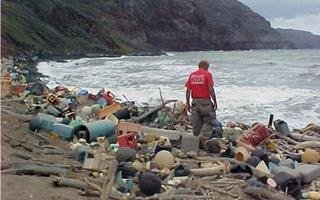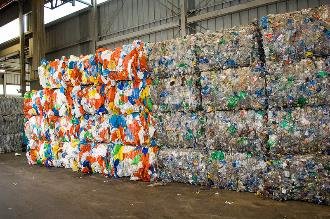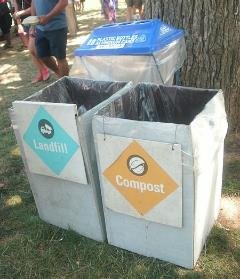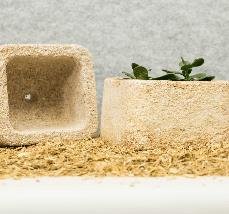
How Can Innovation Help Solve the Plastic Waste Crisis?
Our dependence on plastics, particularly plastic packaging, has generated an enormous amount of plastic waste that is accumulating in the oceans at an alarming rate. A new study by Pew Charitable Trusts and SYSTEMIQ, Ltd. estimates that by 2040, if current trends continue, the amount of plastic waste released globally into the oceans will triple to nearly 32 million tons per year. According to Pew, this is the equivalent of dumping 110 pounds of plastic on every meter of coastline around the world. Plastic waste in the environment persists for hundreds to thousands of years and creates serious risks for wildlife, their habitats, and humans.

About 40% of all plastic produced is used for disposable packaging, which is the single largest market for plastic materials. In response to growing concern about the plastic waste crisis, some businesses have been working to develop more sustainable types of plastic packaging. Others are creating and promoting the use of new materials that can serve as substitutes for plastic packaging. The sections below provide some examples of innovative new plastic and non-plastic materials that companies are developing in the hopes that they will help alleviate the plastic waste problem. However, each comes with its own set of tradeoffs and challenges. Ultimately, the most effective way to reduce waste from plastic packaging is to use less packaging in the first place. That is why several companies are creating new systems for utilizing reusable containers to distribute food and consumer goods. Several examples of new reuse models are described below.
Can We Engineer Plastic Packaging to Be More Sustainable?
You have probably heard of bio-based plastic, biodegradable plastic, or compostable plastic Many of the products that are marketed as more sustainable types of plastic fall under one or more of these categories, but it is important to understand what these labels do and do not mean.

The term “plastic” is used to describe a large family of synthetic polymers that are created by linking together repeating chains of carbon-based units known as monomers. The specific properties of a plastic, like durability and flexibility, depend on the types of monomers used to make the polymer, the way in which the monomers are bonded together, and the additives used. While all plastics are a type of polymer, not all polymers are plastic. The synthetic (man-made) polymers that make up plastic are traditionally made from petrochemicals and are engineered to resemble polymers found in nature (biopolymers), such as silk, wool, amber, or rubber.
Bio-based plastics (also referred to as “bioplastics”) are simply plastics that are made from renewable materials, such as soy or corn, rather than fossil fuels. You may have even used one of the many available bioplastic products, like utensils and takeout food containers. Bio-based products have the benefit of reducing our reliance on fossil fuels by using renewable resources instead. However, bio-based plastics are not necessarily biodegradable, and just like petroleum-based plastics, bio-based plastics can last in landfills and in the environment for hundreds or thousands of years, depending on their chemical structure and properties.
If a plastic is biodegradable, it means that it can be completely broken down by microbes. Both petroleum-based and bio-based plastics can be engineered to biodegrade into carbon dioxide/methane, water, and biomass over time and under certain environmental conditions. However, there is enormous variation in the amount of time required and the environmental conditions necessary for products that are labeled “biodegradable” to completely break down.

Some biodegradable plastics are also compostable, meaning that they biodegrade under certain conditions (e.g. the right amount of heat, moisture, and microbes) into soil conditioning material- i.e. compost. Importantly, many of the plastic products that are labelled “compostable” can only be broken down through treatment at a special industrial composting facility and will not break down in a landfill, a home compost pile, or in the environment.
When compostable plastics became available, some businesses embraced them as more sustainable alternatives to traditional plastic items. However, without clear labelling and due to a lack of access to industrial composting facilities, most industrially compostable products ended up in incinerators or landfills. Many American municipalities do not have the necessary infrastructure or waste management systems in place to collect and process compostable plastics. Because compostable plastics are visually very similar to traditional plastics, compost facilities that do accept compostable plastics often find it difficult to distinguish compostable plastic materials from traditional plastics, and compostable plastics may be removed during the sorting process and sent to landfills.
Due to inadequate labelling of compostable plastics, consumers may accidentally dispose of them in the recycling bin. If mixed in with recyclable plastics, the compostable materials can lower the quality of the final recycled product or damage equipment at recycling facilities.
While new innovations in plastic engineering may help solve the plastic waste problem in the future, right now, the use of plastic materials labelled as “biodegradable” or “compostable” cannot significantly reduce the amount of plastic entering our waterways.
What About Non-Plastic Packaging?
In some cases, plastic packaging can be replaced entirely by alternative materials that provide the necessary functions of plastic without the harmful waste. Businesses and researchers have been exploring a wide range of new materials, but finding alternatives is challenging, since the very qualities that make plastic an attractive material for packaging – its durability and low cost – are what have led to the massive plastic waste crisis we currently face.

As mentioned previously, some polymers occur naturally. For example, wool and silk are protein fibers that are used to make clothing and chitin is the polymer that makes up the exoskeleton of crustacean and insects. Most natural polymers tend to biodegrade much faster than plastic. Cellulose from plants, for example is a naturally occurring polymer that is the main ingredient in paper and cardboard. Paper packaging is often used as an alternative to plastic, but it is not water resistant like plastic and therefore, is usually not suitable as a container for liquids. Plus, paper packaging comes with its own set of environmental impacts, including the relatively high amount of energy used to produce and transport it.
Recently, researchers have been working on using fungal mycelium to produce packaging. Mycelium is the body of fungi, which consists of a mass of branching threads. Companies have found ways to use mycelium to bind together organic materials like wood chips and agricultural byproducts to create biodegradable packaging, which several businesses are already using to ship high-value goods.
Another packaging innovation that has received a lot of attention in recent years is seaweed-based food packaging material. Several companies are working on producing and promoting various types of seaweed-based packaging that can hold dry goods, water, and other liquids. The creators of one type of seaweed-based flexible packaging hope that their edible pods can replace the small plastic containers for sauces and condiments used in restaurants. They have also developed a waterproof and biodegradable liner that can be applied to cardboard food packaging. This could help to replace plastic-coated cardboard cups and food containers, which are non-recyclable and non-biodegradable.
The biodegradable packaging innovations mentioned here are only a small sample of the many ways in which researchers are using natural polymers to create more sustainable alternatives to plastic packaging. In general, these new technologies are far more expensive than plastic and we are far from seeing the widespread adoption of mycelium- or seaweed-based materials as alternatives to plastic. For now, the most effective way we can help reduce plastic waste is to reduce the amount of packaging we consume in the first place.
New Reuse Models to Help Reduce Plastic Packaging
Many Americans have already made the switch from disposable plastic water bottles and plastic shopping bags to reusable ones, but there are limits to the amount of plastic packaging that we can easily cut out of our lives. When we buy takeout food, groceries, and many other products, we often end up with the plastic containers or wrappers in which they are sold. Some companies are trying to change this by introducing new models for selling goods in reusable packaging.

In the past two years, several plastic waste-free grocery delivery services were launched. Through these services, customers can go online and order groceries, which are delivered in reusable containers. After using the product, the consumer returns the packaging to be cleaned and refilled. One of the companies offering zero-waste grocery shopping works with consumer goods companies to sell brand-name products in reusable packages both online and in participating stores. Customers pay a refundable deposit for a reusable container when they purchase products like ice cream, cereal, mouthwash, or detergent. This is not a completely new concept. In fact, two of these companies describe their systems as being inspired by the old-fashioned “milkman model,” in which milk was delivered in glass bottles that were picked up and reused.
Zero-waste grocery delivery services offer a promising model for reducing our reliance on plastic packaging, but they are not yet a viable option for all Americans. Currently, these grocery services are only available in limited areas around the country and there are additional costs associated with these services, which could prevent some consumers from using them.
Around the world, we are seeing a proliferation of new reuse models, which are described in detail in a 2019 report by the Ellen MacArthur Foundation and New Plastics Economy. Though reusable containers are not always a viable alternative to disposable packaging, these innovations are enabling producers and consumers to rethink the role of disposable plastic packaging in our supply chains and provide alternatives when possible.
The availability of cheap and versatile plastic packaging has influenced the way we transport, sell, and consume goods as well as the systems we have created to manage our waste. No single solution will fix our massive plastic waste problem. Instead, slowing the flow of plastic waste into the oceans requires dramatic changes to the way we produce, use, recycle, dispose of, and value plastic. Innovations in sustainable packaging materials have the potential to be a part of the solution, but only if they are coupled with large-scale efforts to reduce the amount of packaging that we use.
You can learn more about how you can take action in your home and community to keep trash out of waterways by visiting the Trash Free Waters website.
This article is the third in a series produced by EPA’s Trash-Free Waters program and the National Environmental Education Foundation. Mention of trade names or commercial products does not constitute endorsement or recommendation for use.


